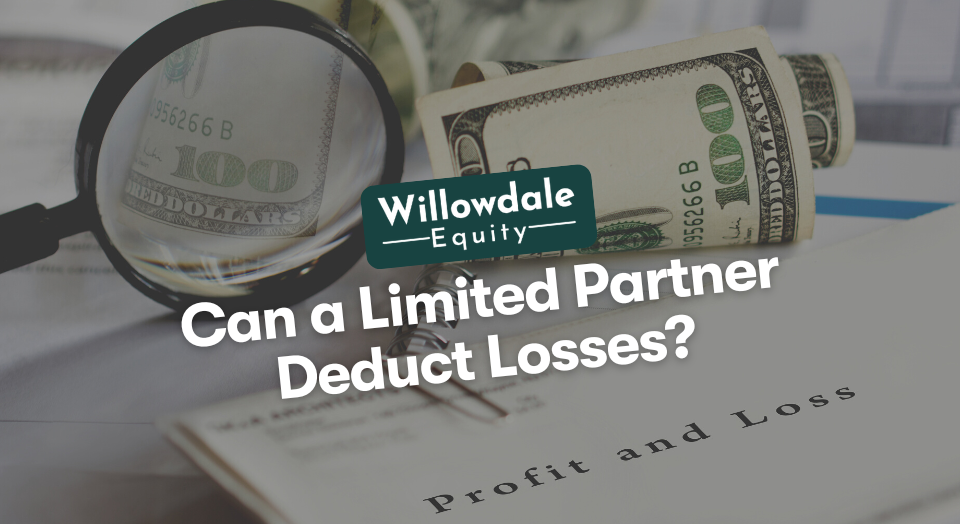
Can a Limited Partner Deduct Losses?
This article is part of our passive investors guide on real estate syndications, available here.
While tax codes for investors are notoriously cumbersome, this is one area where new investors can get some clear-cut answers. The ability to deduct your losses on your tax return to reduce or eliminate either your capital gains or ordinary income is a core benefit for investors.
However, only investors who know how to reclassify losses can erase gains from their W-2 jobs. We’ll examine how limited partners can get the most tax advantages possible using an IRS-approved method.
Key Takeaways
-
Yes, a limited partner can legally deduct losses from the business for both passive and non-passive activity.
-
Under ordinary circumstances, the partnership is responsible for calculating a K-1 tax form detailing each limited partner/passive investor’s share of the firm’s income, losses, deductions, and credits.
-
Qualifying as a real estate professional while proving your “material participation” in your rental real estate, partnership losses can shelter against your other income.
Is a Limited Partner Always Passive?
Yes, limited partners are always passive by default under the current law. The IRS’s assumption with a passive partnership is that the passive taxpayer does not materially participate in the business on a regular, continuous, and substantial basis. This is true regardless of how much participation the passive partner puts into the business–unless that partner qualifies as a real estate professional.
Suppose a partner who can be said to participate in a business materially obtains something called real estate professional status. In that case, they can shift into a participation category called non-passive business activity. Next, I’ll show you what a limited partner means for deducting losses under nonpassive income and passive activity rules.
Can a Limited Partner Deduct Losses?
Yes, a limited partner can legally deduct losses from the business for both passive and non-passive activity. However, the tax benefits for both categories are far from equal. Under ordinary circumstances, the partnership is responsible for calculating a K-1 tax form detailing each limited partner/passive investor’s share of the firm’s income, losses, deductions, and credits. All distributions paid out during the tax year must also be shared on the K-1.
If a partner’s share of a limited partnership income or losses for the tax year exceeds its outside basis, recently upgraded IRS rules allow the losses to the extent of basis with any excess amount to be carried forward to future years with an available outside basis. The next thing to consider is how partnership losses offset other taxable income.
Can Partnership Losses Offset Against Other Income?
Qualifying as a real estate professional while proving your “material participation” in your rental real estate, partnership losses can shelter against your other income.
By now, most people know that you can use the “paper losses” caused by depreciation to reduce your tax burden for the property. Next, I’ll break down how to offset against your ordinary income outside of a limited partnership using this loophole.
Good Read: The Real Estate GP Fund in CRE
Offsetting Real Estate Losses Against Ordinary Income

The Taxpayer Relief Act of 1986 closed the passive activity loophole by preventing limited partners from deducting their losses. However, the nifty real estate professional loophole allows you to reclassify your passive activity losses as non-passive to offset personal income. Yes, that means W2 income from your regular job.
So that would mean you have to own at least 10% of the business, actively participate, and not be a limited partner to offset other passive income losses against personal income.
For those who qualify, rental real estate losses up to $25,000 may be deducted by an individual whose modified adjusted gross income is less than $100,000. Next, I’ll give the basics on how to prove that you materially participate in a limited partnership to benefit financially from deductions.
Proving Material Participation
You’ll need to prove material participation in a limited partnership after proving that you qualify as a real estate professional if you want non-passive income deductions. The gist is that you’re providing that you actively put hundreds of “investor hours” of direct participation into your properties.
For most people, the easiest way to get in those hours is to simply manage their properties as hands-on landlords instead of hiring third-party property management services. Consider common questions about deducting losses from passive activity in limited partnerships.
Good Read: What is Preferred Return in Multifamily Investing?
Frequently Asked Questions About Deducting Losses As a Limited Partner
Yes, both general and limited partners share in losses; however, limited partners enjoy limited liability while general partners do not. When you’re a limited partner, you enjoy the benefits of “passive activity” deductions based on property depreciation by default. However, a loophole allows you to reclassify your losses as non-passive losses to reap the benefits of offsetting losses against your ordinary W-2 income for greater tax perks.
All income earned by a limited partner is counted as passive income instead of earned income by default. To get the tax benefits of an active participant, a limited partner must meet the criteria set by the passive loss rules to reclassify their passive losses as non-passive losses by proving their “real estate professional status”. This essentially means proving that you put in the effort and time required by the IRS to make you an active participant.
Losses in partnerships are generally equally spread among the investors based on their ownership interest in the partnership. This allows investors to offset their gains to reduce their tax burden.
Passive Investing Deductions for Limited Partners - Conclusion
Investors in limited partnerships can leverage tax rules to use their losses to offset gains. Suppose you can prove that you materially participated in the business activities of a limited partnership. In that case, the IRS will reclassify your passive activities into non-passive activity using the real estate professional loophole.
This ultimately means that you can use “paper losses” from your limited partnership interests to shelter yourself against the ordinary tax burden from earned income from your job. Keeping more of your income after taxes places you in the position to invest in more properties and sponsor projects that will enable you to continue to build on tax loopholes that offset active income, portfolio income, and W-2 payments, all without being a general partner.
This is just the beginning of how smart investors continuously use hard assets like real estate to earn, keep, and reinvest more income. Join the investor club here at Willowdale Equity to access our resources and private value-add multifamily passive investment opportunities across the southeastern United States.
Sources:
The Willowdale Equity Investment Club is a private group of investors that are looking to passively grow their capital and share in all the tax benefits through multifamily real estate investments.






